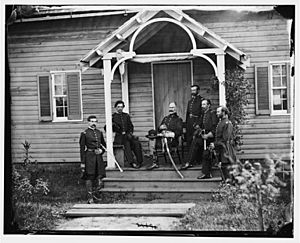Marsena R. Patrick facts for kids
Quick facts for kids
Marsena Rudolph Patrick
|
|
|---|---|

Marsena R. Patrick
|
|
| Born | March 15, 1811 Hounsfield, New York |
| Died | July 27, 1888 (aged 77) Dayton, Ohio |
| Place of burial |
Dayton National Cemetery, Dayton, Ohio
|
| Allegiance | United States of America Union |
| Service/ |
United States Army Union Army |
| Rank | |
| Battles/wars | American Civil War |
Marsena Rudolph Patrick (born March 15, 1811 – died July 27, 1888) was an important figure in American history. He was a college president and a respected officer in the United States Army. During the American Civil War, he served as a general for the Union forces. He is best known for being the provost marshal (like a chief of military police) for the Army of the Potomac during many key battles.
Early Life and Career
Marsena Patrick was born in Hounsfield, New York, near Watertown, New York. When he was young, he worked on the Erie Canal and also taught at a school for a short time. He then got the chance to attend the United States Military Academy in West Point, New York. He graduated from West Point in 1835.
After graduating, Patrick became a second lieutenant in the infantry. He was promoted to first lieutenant in 1839. He served in the Seminole Wars and later in the Mexican–American War. During the Mexican-American War, he was promoted again, this time to captain in 1847. He even became a brevet major in 1849 for his excellent service in enemy territory. However, in 1850, Patrick decided to leave the Army and returned to New York.
Back in New York, he became the president of the Sackett's Harbor and Ellisburgh Railroad. He also became a very skilled farmer, using new scientific methods to improve his crops. In 1859, Patrick was chosen to be the president of the New York State Agricultural College. He held this position for two years. When the Civil War began in 1861, Patrick joined the New York state militia as an inspector general.
Civil War Service
In March 1862, Marsena Patrick was made a brigadier general of volunteers. His group of soldiers was sent to the Shenandoah Valley in northern Virginia. There, his men sometimes fought against Confederate soldiers led by Stonewall Jackson. In April 1862, he was also made the military governor of Fredericksburg, Virginia.
Later that year, Patrick's unit joined the Army of the Potomac. This army was led by Maj. Gen. George B. McClellan. Patrick commanded a brigade (a large group of soldiers) that helped defend Washington, D.C. His brigade fought bravely in the Maryland Campaign, including the battles of South Mountain and Antietam. They suffered many casualties in these fights.
After the Battle of Antietam, Patrick was given a very important job. On October 6, 1862, he became the provost marshal for the Army of the Potomac. This meant he was in charge of military police duties, keeping order, and managing prisoners. To help him, he had many different units under his command, including:
- McClellan (Illinois) Dragoons
- 9th New York Infantry
- 93rd New York Infantry
- 2nd U.S. Cavalry
- 8th U.S. Infantry
- 2nd Pennsylvania Cavalry
- 6th Pennsylvania Cavalry
- Regular cavalry units
- 21st New York
- 23rd New York
- 35th New York
- 80th New York (20th Militia)
- Maryland Light Artillery, Battery B
- Ohio Light Artillery, 12th Battery
In November, Patrick tried hard to stop Union soldiers from looting and damaging Fredericksburg. He also had to deal with political leaders who blamed him for problems. Despite these challenges, Patrick continued as provost marshal throughout 1863. When Joseph Hooker took command of the army, he asked Patrick to create the Bureau of Military Information. This was a network of intelligence agents who gathered important information.
At the famous Battle of Gettysburg, Patrick was responsible for handling thousands of Confederate prisoners of war. In early 1864, when General Ulysses S. Grant took charge of all the Union armies in the East, Patrick's role grew even bigger. He became the provost marshal for all the combined forces fighting against Richmond, Virginia.
After the War
After Robert E. Lee surrendered in April 1865, Marsena Patrick stayed in northern Virginia. He served as the provost for the District of Henrico. He was promoted to brevet major general in the volunteer army. However, Patrick decided to leave the Army for a second time on June 12, 1865. He preferred to return to civilian life rather than stay in the smaller regular army after the war.
In 1865, he ran for New York State Treasurer as a member of the Democratic party. However, he was defeated by the Republican candidate.
Patrick then moved to Manlius, New York. From 1867 to 1868, he served as the president of the New York State Agricultural Society. He also worked as a state commissioner for several years. He became a well-known public speaker, especially on new technologies in farming. Patrick was also very interested in helping former soldiers. He moved to Ohio and became the governor of a special home for disabled volunteer soldiers.
Marsena Patrick passed away in Dayton, Ohio. He was buried in the Dayton National Cemetery. His personal diary, which often shared his thoughts about the Army's commanders, was published in 1964.


